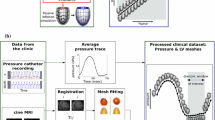Summary
Computer techniques have been developed to achieve a least-squares fit of the Hodgkin and Rushton one time-constant cable equation to the recorded responses of muscle cells to the intracellular injection of square current pulses. In the rat diaphragm the response of the muscle fiber to square current pulses is well fit by a one time-constant model. This makes possible the estimation of the passive electrical properties of muscle sarcolemma using the response of the fiber to a single stimulus. A comparison of the results of this method and the older method of spatial decay in the rat diaphragm shows no significant differences. Average values obtained using the one-point method for estimating membrane resistance and capacitance are 520 Ω cm2 and 4.6 μF/cm2, respectively. An estimation of the average specific resistivity of the cytoplasm was made using this method, and it was found to be 213 Ω cm. At levels of injected currents producing large membrane hyperpolarizations where delayed conductance changes make the spatial decay method useless, the one-point method continues to give consistent results since it utilizes only the early portion of the membrane response. Work with the frog sartorius muscle, which is known to display the characteristics of a two time-constant system, shows that this method is capable of estimating the slower components of this system by using only the later portion of the response curve. The immunity of this method to delayed conductance changes and its experimental facility make it useful in estimating the passive electrical properties of muscle fibers, particularly when working with tissues that are small and delicate or that have poorin vitro viability.
Similar content being viewed by others
References
Blackburn, J. A. 1970. Spectral Analysis: Methods and Techniques. Marcel Dekker, New York
Bretag, A. H. 1970. Muscle Cell Membranes and Chloride Ions. Ph. D. Thesis, University of Adelaide (Australia)
Camerino, D., Bryant, S. H. 1976. Effects of denervation and colchicine treatment on the chloride conductance of rat skeletal muscle fibres.J. Neurobiol. 7:221
Eisenberg, R. S., Vaughan, P. C., Howell, J. N. 1972. A theoretical analysis of the capacitance of muscle fibres using a distributed model of the tubular system.J. Gen. Physiol. 59:360
Falk, G., Fatt, P. 1964. Linear electrical properties of striated muscle fibres observed with intracellular electrodes.Proc. R. Soc. London B 160:69
Hodgkin, A. L., Nakajima, S. 1972. The effect of diameter on the electrical constants of frog skeletal muscle fibres.J. Physiol. (London) 221:105
Hodkin, A. L., Rushton, W. A. H. 1946. The electrical constants of a crustacean nerve fibre.Proc. R. Soc. London B 133:444
Hutter, O. F., Warner, A. E. 1972. The voltage dependence of the chloride conductance of frog muscle.J. Physiol. (London) 227:275
Kiyohara, T., Sato, M. 1967. Membrane constants of red and white muscle fibres in the rat.Jpn. J. Physiol. 17:720
Palade, P. T., Barchi, R. L. (1977). Characteristics of the chloride conductance in muscle fibers of the rat diaphragm.J. Gen. Physiol. (in press)
Rudel, R., Senges, J. 1972. Experimental myotonia in mammalian skeletal muscle: Changes in membrane properties.Pfluegers Arch. 331:324
Valdiosera, R., Clausen, C., Eisenberg, R. S. 1974. Circuit models of the passive electrical properties of frog skeletal muscle fibres.J. Gen. Phys. 63:432
Valdiosera, R., Clausen, C., Eisenberg, R. S. 1974. Impedance of frog skeletal muscle fibres in various solutions.J. Gen. Phys. 63:460
Valdiosera, R., Clausen, C., Eisenberg, R. S. 1974. Measurement of the impedance of frog skeletal muscle fibres.Biophys. J. 14:295
Westgaard, R. H. 1974. Influence of activity on the passive electrical properties of denervated soleus muscle fibres in the rat.J. Physiol. (London) 251:683
Whittaker, E., Robinson, G. 1944. The Calculus of Observations (4th, ed.) Dover Publications, New York
Zolovick, A. H., Norman, R. L., Fedde, M. R. 1970. Membrane constants of muscle fibres of rat diaphragm.Am. J. Physiol. 219:654
Author information
Authors and Affiliations
Rights and permissions
About this article
Cite this article
Farnbach, G.C., Barchi, R.L. Determination of muscle cable parameters from a single membrane voltage response. J. Membrain Biol. 32, 133–149 (1977). https://doi.org/10.1007/BF01905213
Received:
Revised:
Issue Date:
DOI: https://doi.org/10.1007/BF01905213




